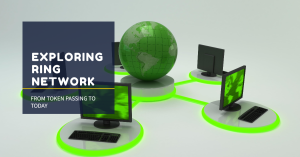Quantum networking is investigating the cutting edge of the technological revolution. Due to the prospect of ultrafast data encryption and better communication systems, it will eventually change the face of information technology. This inclusive exploration trails through the details of quantum networks, ranging from the fundamental principles to the actual applications and problems they face.
Principles of Quantum Networking

Quantum Entanglement
A quantum network uses a complex phenomenon called quantum entanglement. In this case, particles are linked to each other so that the state of one particle will determine the state of another entangled particle, no matter how far they are separated. This property of obviousness facilitates the implementation of encrypted communication channels due to the utilization of the correlations inherent to entangled particles. For instance, the key generation process is based on entangled particles in quantum communication protocols such as Quantum Key Distribution (QKD). Any intercept or eavesdropping of the communication will naturally disfavor the delicate quantum state of the entangled particles, therefore causing the underlying users of the intrusion to be alert.
Superposition
The second brain of quantum networking consists of superposition, an idea that is hard to understand in classical physics. In the quantum dimension, particles like qubits—the bases of quantum information—can be found in different states at the same time. This special feature makes it possible for quantum computers to execute parallel computations far exceeding what classical computers can do. Apart from that, superposition is a factor that increases the ability and speed of data transmission in quantum communication networks. By encrypting data into qubits in superposition states, quantum networks could convey and manipulate large volumes of data more effectively than classical communication systems.
Quantum Key Distribution
Ensuring Secure Communication
Quantum Key Distribution (QKD) forms the core of the hardware support that guarantees the security of quantum networking. Contrary to cryptographic methods, which are based on the computational complications of mathematical algorithms, QKD uses unconditional security based on quantum mechanics theories. QKD is the process of generating and exchanging cryptographic keys in the form of quantum particle states; the photon particle is usually used.
The quantum key can be intercepted or measured at any time by any enemy that could easily disrupt its delicate superposition or entanglement. Therefore, the key that has been intercepted cannot be used for decryption. Hence, quantum key distribution enables the leading secure method for meaning cryptographic keys, maintaining the privacy and correctness of communication over quantum networks.
Advantages Of Classical Cryptography
The single most compelling strength of quantum key distribution compared to classical cryptography is absolute security. The basics of classical cryptographic techniques like RSA and AES depend on the complex nature of specific mathematical issues for their security. Nonetheless, these methods are vulnerable to attacks by quantum computers that utilize algorithms like Shor’s algorithm, which permits efficient solving of problems such as integer factorization and discrete logarithms.
Conversely, QKD is fundamentally based on quantum mechanics, and quantum cryptography is immune to computational complexity. While unlimited computational power is at the adversary’s disposal, eavesdropping on encrypted data cannot be successful without detection, either by disturbing the entangled states of particles or the superposition states of qubits, so legitimate users are therefore alerted to the attempt.
Challenges in Quantum Networking
Quantum Decoherence

Quantum networking is hampered by one of its major obstacles: quantum decoherence, where coherence or quantum features of qubits that are the quantum units of the information are lost due to the interaction with the surrounding environment. Different factors, like electron thermal fluctuations, electromagnetic interference, and material defects, can trigger decoherence. Unless it is disrupted, quantum decoherence can affect the quality of quantum information and, as a result, the reliability of the quantum communication channels. Restraining decoherence requires implementing techniques that can control environmental factors precisely and developing error correction methods to restore the coherence of qubits.
Technical Limitations
The practical design of quantum networks confronts technical restrictions that act as progress-breaking barriers. The other constraint is the presence of stable and scalable hardware that can reliably handle the manipulation and measurement of quantum states. Today’s quantum technology, including defective superconducting qubits and trapped ions, is also subject to noise and error; thus, further development of intelligent and fault-tolerant computing architectures is urgently necessary. Moreover, because of proven effective error correction methods, errors arising during quantum operations can be reduced to ensure the safekeeping of quantum information. These technical issues represent hurdles that must be overcome to unleash the full power of quantum networks and reap the benefits they provide for practice and application.
Advancements in Quantum Networking Research
Quantum Repeaters
Scientists are conducting intense research to combat the decoherence caused by existing quantum communication systems and have already made several quantum repeaters. Quantum repeaters are the devices that amplify and also relay quantum signals over long distances, whereas quantum information coherency is not sacrificed. Quantum error correction methods and entanglement purification protocols that quantum repeaters deploy will help with network creation and mitigate decoherence effects so that the creation of global-scale quantum networks is possible. Recent breakthroughs in quantum repeater technology have proven to be a success in the battle against quantum decoherence and have helped to restore and increase the reach of quantum communication.
Quantum Memory
Another area of quantum networking that is being very actively developed is quantum memory, which involves storing and restoring quantum information with high precision and long coherence times. Quantum memory plays an important role in many quantum communication methods, including quantum repeaters and key distribution, where the transferred quantum states must be stored temporarily. Researchers look for various storage approaches to quantum memory, i.e., atomic ensembles, solid-state systems, and photonic crystals, to develop effective and scalable quantum storage solutions. Developments in quantum memory techniques are essential for bringing real quantum communication networks into practice and accomplishing quantum communication at long distances.
Integration with Existing Networks

Compatibility and Interoperability
One of the main features of quantum networking is the natural symbiosis with classical communication technology that already exists. Ensuring compatibility and interoperability within the framework of quantum and classical communication systems is a crucial factor that will enable the establishment of the quantum infrastructure. Efforts to achieve standardization have been initiated by setting up common protocols and interfaces that allow communication between quantum and classical devices. By trying to end the divide between quantum and classical technologies, integration goals intend to set the course for pouring new technologies out into the market and keeping the whole community fully included through hybrid communication networks capable of catering to the different needs of the users.
Transition Strategies
Creating successful transitioning strategies is essential in extensively using quantum communications network technology. The incremental improvements, the pilot projects, and the standards-setting schemes are vital to increasing the performance of classical and quantum information networks. Pilot projects allow organizations to check and evaluate how quantum technologies work, the difficulties, and where the best practices for quality integration are. The main goal of standard-making is to harmonize the protocols and rules for quantum communication, which provides convergence in quantum systems of dissimilar kinds. Through a strategy-based and gradual approach to implementation, organizations mitigate risks and increase the upside.
Applications of Quantum Networks
Scientific Sensing
Quantum networks are key for scientific sensor applications because of their unique properties of capability and detection. Detecting gravitational waves, quantum metrology, and precision timing are only a few scientific spheres that fit this context. Using the physical laws of quantum mechanics, researchers can craft and measure quantum states precisely to levels never seen before. At this new level, research is advancing our understanding of the fundamentals of physics and the universe.
Telecommunications

In the telecommunications field, the quantum network offers secure and efficient communication results that prevent the proliferation of information. QE protocols and quantum cryptography systems guarantee the security of data transmission, counteracting cyber threats like eavesdropping or data modification. The anchor of quantum communication technologies includes secure communication in various fields such as military, government, banking, and medical care. It is possible to protect critical information assets and ensure safe communication channels using quantum cryptography’s security advantages.
Cryptography
The application of cryptography in quantum networking goes beyond general information encryption strategies, ensuring safeguarding against security threats posed by quantum computers. Quantum computing, through its ability to carry out Shor’s algorithm for big number factoring and Grover’s algorithm for searching unsorted databases, presents a big threat to cryptographic algorithms currently considered quite secure. Implementing quantum-resistant cryptographic algorithms, such as lattice-based cryptography and hash-based signatures, will offer security provisions that will continue in the era of quantum computers. Using quantum-safe cryptographic methods, organizations can protect their cryptographic environment regardless of such future attacks as quantum assaults.
Conclusion
Quantum networking represents a paradigm shift in information technology, offering unprecedented levels of security, speed, and scalability in communication systems. Despite facing significant challenges, ongoing research and technological advancements continue to pave the way for realizing quantum-enabled networks. By harnessing the principles of quantum mechanics, researchers and engineers are unlocking new possibilities for secure communication, scientific exploration, and technological innovation. As quantum networking technologies mature and become more accessible, they hold the potential to revolutionize diverse fields and shape the future of communication and computing.
FAQs
How does quantum networking differ from classical networking?
Quantum networking utilizes the principles of quantum mechanics, such as superposition and entanglement, to enable secure and efficient communication, whereas classical networking relies on classical physics and mathematical algorithms.
What are the primary advantages of quantum key distribution?
Quantum key distribution offers unconditional security, is immune to eavesdropping attempts, and provides a provably secure method for generating cryptographic keys, ensuring confidentiality and integrity in data transmission.
What role do quantum repeaters play in extending the reach of quantum communication?
Quantum repeaters amplify and relay quantum signals over long distances, mitigating the effects of quantum decoherence and creating global-scale quantum networks.
How can quantum networking benefit scientific sensing applications?
Quantum networks enable precise measurements and manipulations of quantum states, enhancing sensitivity and accuracy in scientific sensing applications such as gravitational wave detection and quantum metrology.
What are the challenges associated with integrating quantum networks with existing infrastructure?
Integrating quantum networks with existing infrastructure requires ensuring compatibility and interoperability with classical communication systems and addressing technical limitations such as quantum decoherence and error correction.




